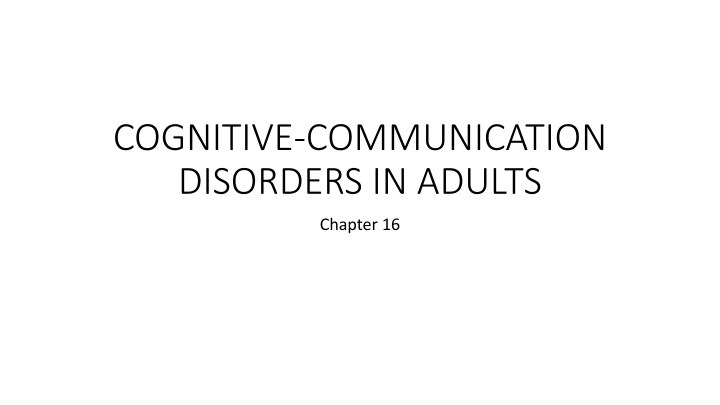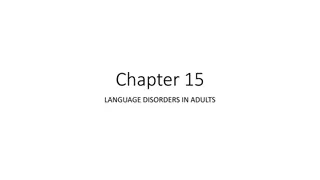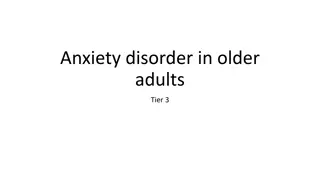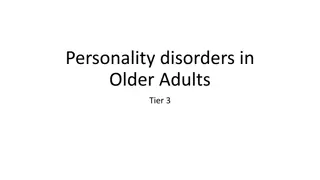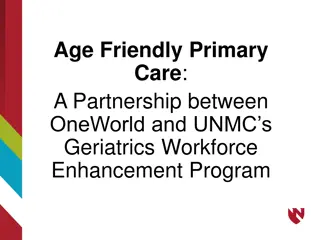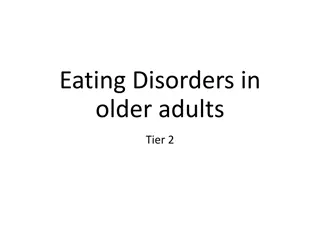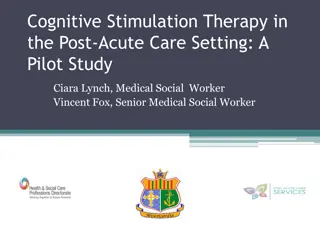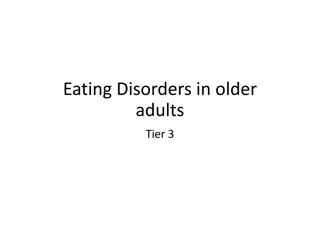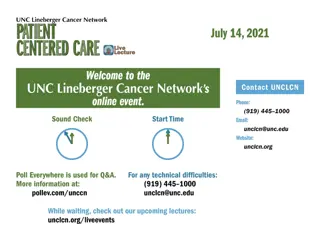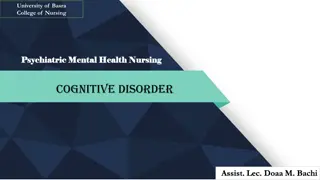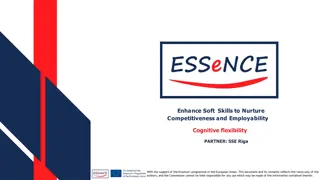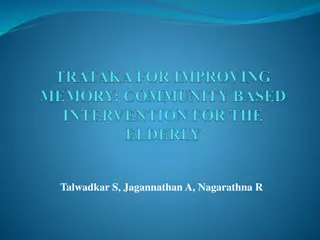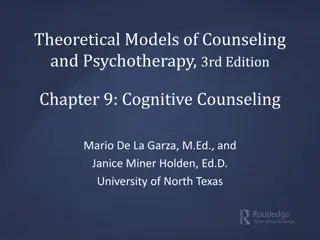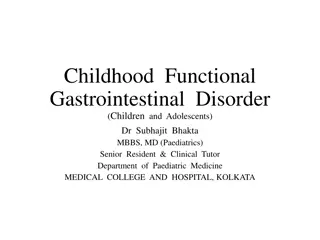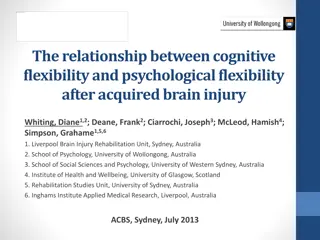COGNITIVE-COMMUNICATION DISORDERS IN ADULTS
Cognitive communication disorders in adults stem from cognitive impairments, affecting reasoning, judgment, organization, and problem-solving. Etiologies include traumatic brain injury, right hemisphere damage, and dementia. Challenges in these disorders include impairments in attention, memory, problem-solving, and executive functioning.
Download Presentation

Please find below an Image/Link to download the presentation.
The content on the website is provided AS IS for your information and personal use only. It may not be sold, licensed, or shared on other websites without obtaining consent from the author.If you encounter any issues during the download, it is possible that the publisher has removed the file from their server.
You are allowed to download the files provided on this website for personal or commercial use, subject to the condition that they are used lawfully. All files are the property of their respective owners.
The content on the website is provided AS IS for your information and personal use only. It may not be sold, licensed, or shared on other websites without obtaining consent from the author.
E N D
Presentation Transcript
COGNITIVE-COMMUNICATION DISORDERS IN ADULTS Chapter 16
Outline I. Introduction II. Right Hemisphere Disorder (RHD) III. Foundations of Traumatic Brain Injury (TBI) IV. Assessment of Persons with TBI V. Intervention for Persons with TBI VI. Dementia
I. INTRODUCTION** Cognitive communication disorders are language problems that occur secondary to cognitive impairment Impaired ability to process and use incoming information for member, reasoning, judgment, organization of information, and problem- solving Most common etiologies: traumatic brain injury (TBI), right- hemisphere damage, dementia
II. RIGHT HEMISPHERE DISORDER (RHD)** Right hemisphere important for attention, emotions, orientation, semantic and pragmatic communication skills Patient may have difficulties with reasoning and problem-solving, attention, memory, orientation, and executive functioning
RHD communication impairments can include:
More RHD challenges:** Violating pragmatics rules interrupting, changing topics, not understanding humor Visual-spatial impairment get lost easily Difficulty recognizing familiar faces, even family Left side neglect
On page 412:** You don t have to know the names of the actual tests we administer
III. FOUNDATIONS OF TRAUMATIC BRAIN INJURY A. Introduction
TBIs** Are a leading cause of death in people under 35 After TBI, 1 in 3 have a permanent disability Lifelong cognitive and communication problems
The ASHA Leader May/June 2024:** They conducted health literacy workshops for children and teens in an at-risk area of the community Brain Health Fair There were brain-engagement stations The kids loved the fair and the hands-on activities We can think about these kinds of experiences to help prevent TBI for children and youth in high risk areas
B. Open Head Injury** Results from skull and brain being penetrated by severe impact or projectiles (e.g., bullets, shrapnel from explosions) Projectile follows a single path
Sometimes there is a coup-contrecoup injury:** Damage to the brain at the site of impact (coup) Also the opposite side (contrecoupe) There is tearing of axons and dendrites, hemorrhaging, etc.
MTBI can have negative impacts:** At work In family relationships People may need a lot more rest than before If frontal lobe damage, problems with memory, focus, multitasking, executive functioning May be more irritable, anxious, depressed, unmotivated
E. Chronic Traumatic Encephalopathy (CTE)** Caused by repeated mild brain traumas Especially concussions in contact sports CTE problems begin around 8-10 years after one experiences repeated concussions Early symptoms are dizziness, headaches, impaired attention
Not on Exam:** Dr. Bennet Omalu has led the way in research on American football players with CTE Movie: Concussion (with Will Smith)
IV. ASSESSMENT OF PERSONS WITH TBI** A. Speech and Language Disorders Difficulties with reading and writing, auditory comprehension, word finding Pragmatics social skills: difficulty interpreting others messages, esp. emotions, gestures, facial expressions Saying inappropriate things, interrupting Interpreting abstract language like making inferences Difficulty with theory of mind understanding another person s perspective
B. Cognitive Impairmentsdifficulties with:** Orientation time, place, person, person/situation Memory acquiring and retaining information Attention Reasoning and problem-solving Executive functioning making and executing plans Attention to details
V. INTERVENTION FOR PERSONS WITH TBI** Team work is critical! Usually PT, OT, speech, psychologist, social worker, doctor Must address behavioral disorders due to disinhibition Overall goals: 1) improve physical, cognitive, and psychosocial functioning; 2) foster independence; 3) facilitate integration into community Tx: regain lost skills, compensate for permanent damage
VI. DEMENTIA** A. Introduction Syndrome caused by a progressive neurological disease Intellectual, cognitive, communicative, behavioral, and personality deterioration Patient shows significant decline from previous level of performance in areas like memory, language, attention, etc. Deficits interfere with carrying out activities of daily living (ADL)
Cognitive reserve:** Brain s resilience ability to cope with increasing damage while still functioning adequately Based on education, new learning, new experiences Higher cognitive reserve: those with advanced education, cognitively complex and challenging professions Someone might have Alzheimer s but not show it because of large cognitive reserve
(not on exam) Its like having a lot of money in the bank:** If you start with lots of money, when some is withdrawn, it won t be as noticeable Catherine: nurse, traveled a lot, very active in her church and with her family: $500 in brain bank Mary: terminated high school early, watched lots of TV all her life, not active--$200 in brain bank
Mom, Alzheimers, and a Conversation https://www.youtube.com/watch?v=iJJerSu8DxE
Stage I: Mild Alzheimers:** Disorientation Lost while driving on familiar streets Impaired working memory Putting items in inappropriate places Mood swings May take out frustration and anger on family and colleagues
Stage III: Severe-Late Stage Alzheimers** Person needs maximal assistance for ADL Minimal/no memory, verbal communication Difficulty recognizing others, self (in mirror) Difficulty chewing and swallowing Average life span after diagnosis is 4-7 years
C. Communication TipsWhen Interacting with Older People and Those with Dementia** Simplify and write down instructions Allow extra time Minimize distractions Speak slowly and be loud enough Frequently summarize most important points Stick to one topic at a time Use short, simple words and sentences Pause!
D. Assessment and Treatment** Diagnosis made by physicians and psychologists We evaluate language, cognition, swallowing For the exam, no names of tests on p. 418 Goals are to 1) maximize current abilities and 2) slow down the progression of deteriorating abilities Counseling the family is key Helping with quality of life for patient and family
Outline I. Introduction II. Right Hemisphere Disorder (RHD) III. Foundations of Traumatic Brain Injury (TBI) IV. Assessment of Persons with TBI V. Intervention for Persons with TBI VI. Dementia
